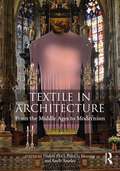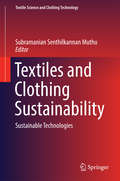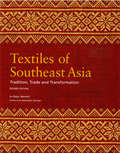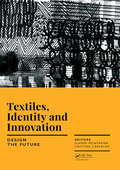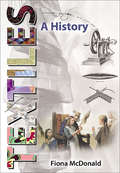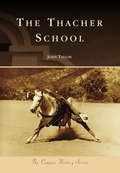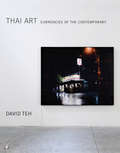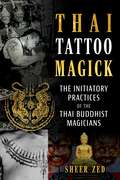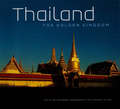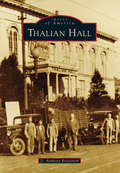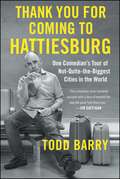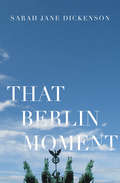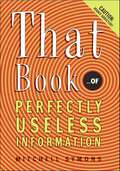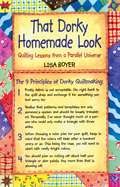- Table View
- List View
Textile Visionaries: Innovation, Sustainability in Textile Design
by Bradley QuinnTechnologized textiles and sustainable fabrics are among the most innovative designed today, and together they are driving the rest of the industry dramatically forward. Many designers are now integrating hi-tech fabrics, such as protective and impact-resistant textiles, or cellulose fabrics with groundbreaking results. Embracing new processes such as biomimicry, they bridge the gap between art, design, technology and sustainability.This book showcases new work from over 35 of today’s most forward-thinking textile designers, featuring surface designs, highly-structured textures and striking silhouettes. Each will be presented through inspirational text and striking visual spreads to include design sketches, work-in-progress photographs and digital drawings alongside images of cutting-edge furniture, interior textiles and fashion.This book shows how the development of fabrics today is immersed in technology, sustainability and innovation. It is an essential resource for anyone interested in contemporary textile design.
Textile in Architecture: From the Middle Ages to Modernism
by Patricia Blessing Didem Ekici Basile BaudezThis book investigates the interconnections between textile and architecture via a variety of case studies from the Middle Ages through the twentieth century and from diverse geographic contexts. Among the oldest human technologies, building and weaving have intertwined histories. Textile structures go back to Palaeolithic times and are still in use today and textile furnishings have long been used in interiors. Beyond its use as a material, textile has offered a captivating model and metaphor for architecture through its ability to enclose, tie together, weave, communicate, and adorn. Recently, architects have shown a renewed interest in the textile medium due to the use of computer-aided design, digital fabrication, and innovative materials and engineering. The essays edited and compiled here, work across disciplines to provide new insights into the enduring relationship between textiles and architecture. The contributors critically explore the spatial and material qualities of textiles as well as cultural and political significance of textile artifacts, patterns, and metaphors in architecture. Textile in Architecture is organized into three sections: “Ritual Spaces,” which examines the role of textiles in the formation and performance of socio-political, religious, and civic rituals; “Public and Private Interiors” explores how textiles transformed interiors corresponding to changing aesthetics, cultural values, and material practices; and “Materiality and Material Translations,” which considers textile as metaphor and model in the materiality of built environment. Including cases from Morocco, Samoa, France, India, the UK, Spain, the Ancient Andes and the Ottoman Empire, this is essential reading for any student or researcher interested in textiles in architecture through the ages.
Textiles and Clothing Sustainability
by Subramanian Senthilkannan MuthuThis book examines in detail key aspects of sustainability in the textile industry, especially environmental, social and economic sustainability in the textiles and clothing sector. It highlights the various faces and facets of sustainability and their implications for textiles and the clothing sector.
Textiles of Southeast Asia
by Mattiebelle Gittinger Robyn MaxwellTraditional textiles are one of the most important and widely collected categories of Southeast Asian art. Formed from an extensive range of locally produced and imported raw materials and an astonishing variety of techniques, Southeast Asian textiles are used to fashion a variety of objects-items from everyday clothing to sacred and ceremonial regalia. This authoritative study considers the various ways Southeast Asian textile artisans reacted over the centuries to the steady stream of new ideas and materials arriving from India, China, the Islamic world, and Europe. Originally published in 1990 by the Australian National Gallery and Oxford University Press of Australia, Textiles of Southeast Asia remains the definitive work on Southeast Asian textiles. This revised edition contains a new foreword and updated color photographs. Unlike other books on the subject, Textiles of Southeast Asia is arranged thematically rather than by country. The result is a strong cultural focus and an analysis of how history influenced the region's textile traditions."
Textiles of Southeast Asia
by Mattiebelle Gittinger Robyn MaxwellTraditional textiles are one of the most important and widely collected categories of Southeast Asian art. Formed from an extensive range of locally produced and imported raw materials and an astonishing variety of techniques, Southeast Asian textiles are used to fashion a variety of objects-items from everyday clothing to sacred and ceremonial regalia. This authoritative study considers the various ways Southeast Asian textile artisans reacted over the centuries to the steady stream of new ideas and materials arriving from India, China, the Islamic world, and Europe. Originally published in 1990 by the Australian National Gallery and Oxford University Press of Australia, Textiles of Southeast Asia remains the definitive work on Southeast Asian textiles. This revised edition contains a new foreword and updated color photographs. Unlike other books on the subject, Textiles of Southeast Asia is arranged thematically rather than by country. The result is a strong cultural focus and an analysis of how history influenced the region's textile traditions."
Textiles of Southeast Asia
by Mattiebelle Gittinger Robyn MaxwellTraditional textiles are one of the most important and widely collected categories of Southeast Asian art. Formed from an extensive range of locally produced and imported raw materials and an astonishing variety of techniques, Southeast Asian textiles are used to fashion a variety of objects-items from everyday clothing to sacred and ceremonial regalia. This authoritative study considers the various ways Southeast Asian textile artisans reacted over the centuries to the steady stream of new ideas and materials arriving from India, China, the Islamic world, and Europe. Originally published in 1990 by the Australian National Gallery and Oxford University Press of Australia, Textiles of Southeast Asia remains the definitive work on Southeast Asian textiles. This revised edition contains a new foreword and updated color photographs. Unlike other books on the subject, Textiles of Southeast Asia is arranged thematically rather than by country. The result is a strong cultural focus and an analysis of how history influenced the region's textile traditions."
Textiles, Identity and Innovation: Proceedings of the 1st International Textile Design Conference (D_TEX 2017), November 2-4, 2017, Lisbon, Portugal
by Gianni Montagna; Cristina CarvalhoD_TEX presents itself as a starting point at a crossroads of ideas and debates around the complex universe of Textile Design in all its forms, manifestations and dimensions. The textile universe, allied to mankind since its beginnings, is increasingly far from being an area of exhausted possibilities, each moment proposing important innovations that need a presentation, discussion and maturation space that is comprehensive and above all inter- and transdisciplinary. Presently, the disciplinary areas where the textile area is present are increasing and important, such as fashion, home textiles, technical clothing and accessories, but also construction and health, among others, and can provide new possibilities and different disciplinary areas and allowing the production of new knowledge. D_TEX proposes to join the thinking of design, with technologies, tradition, techniques, and related areas, in a single space where ideas are combined with the technique and with the projectual and research capacity, thus providing for the creation of concepts, opinions, associations of ideas, links and connections that allow the conception of ideas, products and services. The interdisciplinary nature of design is a reality that fully reaches the textile material in its essence and its practical application, through the synergy and contamination by the different interventions that make up the multidisciplinary teams of research. The generic theme of D_TEX Textile Design Conference 2017, held at Lisbon School of Architecture of the University of Lisbon, Portugal on November 2-4, 2017, is Design the Future, starting from the crossroads of ideas and debates, a new starting point for the exploration of textile materials, their identities and innovations in all their dimensions.
Textiles: A History
by Fiona McDonaldA fascinating and accessible history of textiles, including the key personalities and inventions which revolutionized the industry, together with the East End workshops and the creation of artificial materials such as rayon. Textile expert, Fiona McDonald, includes tips on the care and repair of materials and advice on whats worth collecting and the best materials to wear, as well as safe cleaning, tips on collecting.In addition to a handy glossary of textile terms, there is an A-Z of different textiles, full of interesting facts did you know that velvet was originally made from silk and its name derives from the Latin word, vellus, meaning fleece, or that cabbage was the term used in the rag trade to refer to the extra outfits clever cutters created and sold off the books by careful placement of the pattern. A fascinating and often surprising subject area explored at an accessible but informative level.Did you know? Peau de Soie is a heavy satin which was used for wedding dresses at the turn of the last century. The word satin is derived from Zaytoun, an area of China where it was first made We have lost many evocative names for colors over the years, including bouffon (darker than eau de nil) cendre de rose (gray with pink nuances), dust of Paris (ecru), esterhazy (silver-gray), flys wing (graphite) and terre dEgypt (rust)
Texture Feature Extraction Techniques for Image Recognition (SpringerBriefs in Applied Sciences and Technology)
by Nilanjan Dey Jyotismita ChakiThe book describes various texture feature extraction approaches and texture analysis applications. It introduces and discusses the importance of texture features, and describes various types of texture features like statistical, structural, signal-processed and model-based. It also covers applications related to texture features, such as facial imaging. It is a valuable resource for machine vision researchers and practitioners in different application areas.
Texture: 20 Timeless Garments Exploring Knit, Yarn & Stitch
by Erika KnightLandscapes have long provided a source of inspiration for artists and makers. From the sharp concrete edges of buildings and frosted hedgerows to seaweed strewn beaches and eroded cliffs, there is so much we can take from the environment around us.Texture explores Erika Knight's personal journey through the landscape of knitted fabrics as she examines the different habitats that have inspired her designs throughout her career. Broken down into countryside, city and coast, the core of this book is a compilation of simple knitting recipes that embrace the movement for 'slow fashion' and honour the process of craftsmanship. Each of the 20 garments will teach you how to tackle knitted texture – turn a graphic rib, an intricate lace stitch, and a travelling cable into a covetable collection of jumpers, gloves, hats and socks. Through each of the projects, you will consolidate and build upon new skills that will take your knitting further. With simple and stylish shapes, Erika dispenses her designer tips for creating a series of modern yet timeless garments. Including inspiring photography that showcases the beautiful designs, this book is the ultimate source for knitted texture and belongs on every knitter's bookshelf.
Textured Art: Palette knife and impasto painting techniques in acrylic
by Melissa McKinnonA practical guide to impasto painting for artists of all skill levels to help you create your own unique abstract, landscape, and floral paintings.Author and artist, Melissa McKinnon, has designed this book to take both the beginner and experienced artist on a journey into impasto painting. She begins with an overview of the essential tools and materials you'll need to get started. Included are detailed instructions to make your own stay-wet palette and how to combine thickening mediums with acrylic paint to achieve the ideal consistency.There are simple practice exercises to get you comfortable using a palette knife, mixing colours and blending with a brush. Melissa explains how to sculpt and control the paint to create a variety of stunning textural effects. She demonstrates several mark making techniques that you can use alone or in combination to create your own expressive textured paintings, as well as an introduction to colour theory and tips on composition.Once you feel confident with the tools and paint, you'll learn how to create twelve different textured landscape, floral, and abstract paintings with step-by-step instructions. This series of paintings was designed to help you put all of the techniques and colour theory you've learned into beautiful paintings of your own.Using the instructions in this book you will become equipped to take your practise further and continue to develop the skills you need to improve your artwork. This book will become a trusted resource in your studio, one that you can refer back to again and again as you grow and evolve as an artist.
Textured Stitches: Knitted Sweaters and Accessories with Smart Details
by Connie Chang ChinchioBeloved knitwear designer Connie Chang Chinchio debuts a brand-new collection of 20 knitwear designs showcasing textureTextured Stitches brings Connie's trademark combination of simple knitting with lovely patterned stitches to 20 brand-new flattering, wearable projects. A wide variety of knit garments are featured, including cardigans, gloves, pullovers, jackets, hats, scarves, and more. The patterns are fun to knit, mixing quick and easy stockinette stitch with more involved stitch patterns like lattice, knitted pleats, cables, twisted stitches, and ribbing. The textured stitches help create a tailored knitted fit, while classic stockinette lends drape and polished finish. Knitters of all skill levels will love the must-have, truly wearable appeal of these perfect-for-everyday garments.You'll also learn how textured stitches affect gauge, how yarn choices influence the look of patterned stitches, how to approach shaping, and how to incorporate special cast-on and bind-off techniques. The result is a wardrobe full of stylish and smart knitted sweaters, tanks, tees, and accessories that you'll love to make and wear. Add Textured Stitches to your knitting collection today!
Thacher School, The
by John TaylorSherman Day Thacher, a Yale-trained lawyer, moved west in 1887, intending to join his brother as an orange rancher in California's Ojai Valley. However, after accepting a request from a Yale colleague to tutor his nephew, Thacher's focus changed from cultivating oranges to cultivating young minds. His small educational enterprise eventually became The Thacher School. Combining unmatched academics with a unique horse and camping program, Thacher has prepared more than 5,000 young men and women to become contributing members of society at the local, state, and national levels since its founding in 1889. With an educational philosophy based around Sherman Thacher's precepts of "honor, fairness, kindness, and truth," The Thacher School continues to be recognized as one of the premier secondary schools in the country.
Thai Art: Currencies of the Contemporary (The\mit Press Ser.)
by David TehThe interplay of the local and the global in contemporary Thai art, as artists strive for international recognition and a new meaning of the national.Since the 1990s, Thai contemporary art has achieved international recognition, circulating globally by way of biennials, museums, and commercial galleries. Many Thai artists have shed identification with their nation; but “Thainess” remains an interpretive crutch for understanding their work. In this book, the curator and critic David Teh examines the tension between the global and the local in Thai contemporary art. Writing the first serious study of Thai art since 1992 (and noting that art history and criticism have lagged behind the market in recognizing it), he describes the competing claims to contemporaneity, as staked in Thailand and on behalf of Thai art elsewhere. He shows how the values of the global art world are exchanged with local ones, how they do and don't correspond, and how these discrepancies have been exploited. How can we make sense of globally circulating art without forgoing the interpretive resources of the local, national, or regional context? Teh examines the work of artists who straddle the local and the global, becoming willing agents of assimilation yet resisting homogenization. He describes the transition from an artistic subjectivity couched in terms of national community to a more qualified, postnational one, against the backdrop of the singular but waning sovereignty of the Thai monarchy and sustained political and economic turmoil. Among the national currencies of Thai art that Teh identifies are an agricultural symbology, a Siamese poetics of distance and itinerancy, and Hindu-Buddhist conceptions of charismatic power. Each of these currencies has been converted to a legal tender in global art—signifying sustainability, utopia, the conceptual, and the relational—but what is lost, and what may be gained, in such exchanges?
Thai Garden Style
by Luca Invernizzi TettoniContaining over 250 photographs by world-renowned Italian photographer Luca Invernizzi Tettoni and authoritative text by gardening expert William Warren, Thai Garden Style is a unique book. Showcasing many of the finest contemporary Thai gardens in lavish colour, it contains a wealth of botanical-and other-information. Some of the gardens are in private homes, others in top international hotels and resorts, and each is a fantastic portrayal of tropical luxuriance.
Thai Tattoo Magick: The Initiatory Practices of the Thai Buddhist Magicians
by Sheer Zed• Details the author&’s profound encounters with Thai magick during 4 separate pilgrimages to Thailand• Explains the ritual process of the author&’s multiple Sak Yant tattoos as well as other powerful magickal rituals and initiations he experienced• Shares how his initiatory experiences with Thai Buddhist magicians helped him destroy his destructive former selves and discover profound healing for his mind and soulSharing his profound encounters with Thai magick during four separate pilgrimages to Thailand, writer and musician Sheer Zed details the intense personal initiations and rituals he experienced with the sect of Thai Buddhist magicians known as Ajarns.Traveling all over Thailand to meet with holy monks in sacred places, the author undergoes powerful Thai magickal rituals. Among these are the Gold Face Blessing, where gold leaf was hammered onto his face to form a mask, and a Satuang ritual, traditionally performed for returning soldiers, that crescendos with the release of 21 unruly catfish into the Ping River during a Wolf Moon. As Zed explores the cultural context of Thai Buddhist necromancy, he details firsthand the pain and transformation of his multiple talismanic Sak Yant tattoos, ritually done by hand by Ajarns in magickal inks, including one that spiritually transformed him into a tiger. He shares his experiences of intense Serm Duang ritual baths, the insertion of a gold Takrut needle into his arm, and a rare initiation to connect him directly with spirits.Revealing the extreme personal losses and traumas that led to his spiritual transformation, Zed shares how his initiatory experiences with Thai Buddhist sorcerers helped him destroy his destructive former selves and discover profound healing for his mind and soul. Exploring chaos magick, pop culture, and esoteric Buddhism, he also examines the artistic and occult influences that shaped him into a magickal practitioner—from the underground electronic music scene and the work of the Beat Poets to the writings of Aleister Crowley and the Buddhist Anarchism of Gary Snyder.
Thailand: The Golden Kingdom
by Luca Invernizzi Tettoni William WarrenThis volume is a stunning visual representation of all aspects of the Thai life and culture. Author and long-term resident William Warren, provides an insightful overview of the history and geography of the kingdom, as well as a detailed exploration of the rich tradition of Thai arts and crafts, religion and cultural events. Soaking up the sun on a beach, visiting a wat, partaking in one of the numerous festivals or browsing in the art and antique shops are all part of the essentially "Thai Experience" shared here.
Thais in Los Angeles (Images of America)
by Beatrice Tippe" Morlan Chanchanit MartorellLos Angeles is home to the largest Thai population outside of Thailand. With a relatively recent history of immigration to the United States dating to 1965, reports estimate that 80,000 Thais make their home in Southern California. In spite of its brief history in the United States, the Thai community in Los Angeles has already left its mark on the city. While the proliferation of Thai-owned businesses and shops has converted East Hollywood and some San Fernando Valley neighborhoods to destinations for cultural tourism, the Thai community in Los Angeles County reverberates still from global attention over the 1995 El Monte human trafficking case. The great popularity of Thai cuisine, textiles, and cultural festivals continues to preserve, enrich, and showcase one of Asia's most distinctive cultures.
Thalian Hall
by D. Anthony RivenbarkThalian Hall is one of the oldest and most beautiful theaters in America. Forming the east wing of Wilmington's iconic city hall, this dual-purpose building has been at the center of the community's cultural and political life since it first opened in 1858. Thalian Hall is the only surviving theater designed by John Montague Trimble, one of America's foremost 19th-century theater architects. It was built at a time when Wilmington was the largest city in North Carolina. Thalian Hall is the embodiment of a tradition of performance that stretches back for over two centuries. It has hosted Shakespearean tragedies, musical concerts, and even boxing and wrestling events. For generations, Wilmington audiences have witnessed touring stars, local actors, musicians, dancers, and movies in a parade of performances and celebratory events. The story of Thalian Hall is an embroidered tapestry reflecting the history of the American theater and the community that built it.
Thank You for Coming to Hattiesburg: One Comedian's Tour of Not-Quite-the-Biggest Cities in the World
by Todd BarryFrom the veteran comedian and actor from The Wrestler and Louie comes a hilarious book of travel essays from his time on tour through secondary markets in the US, Canada, and Israel.Hello. It’s Todd Barry. Yes, the massively famous comedian. I have billions of fans all over the world, so I do my fair share of touring. While I love doing shows in the big cities (New York, Philadelphia), I also enjoy a good secondary market (Ithaca, Bethlehem). Performing in these smaller places can be great because not all entertainers stop there on tour; they don’t expect to see you. They’re appreciative. They say things like “Thank you for coming to Hattiesburg” as much as they say “Nice show.” And almost every town has their version of a hipster coffee shop, so I can get in my comfort zone. My original plan was to book one secondary market show in all fifty states, in about a year, but that idea was funnier than anything in my act. So, instead of all fifty states in a year, my agent booked multiple shows in a lot of states, plus Israel and Canada. Thank You For Coming to Hattiesburg is part tour diary, part travel guide, and part memoir (Yes, memoir. Just like the thing presidents and former child stars get to write). Follow me on my journey of small clubs, and the occasional big amphitheater. Watch me make a promoter clean the dressing room toilet in Connecticut, see me stare at beached turtles in Maui, and see how I react when Lars from Metallica shows up to see me at a rec center in Northern California. I’d love to tell you more, but I need to go book a flight to Evansville, Indiana.
Thank You, Stinky Face (Stinky Face Ser.)
by Lisa McCourtOur beloved Stinky Face is back asking Mama another timely and endearing question: Mama, are you thankful for me?In this new, original Stinky Face story, Mama tells her little one that she's thankful for him. Stinky Face, of course, has a question. With greasy, taco-covered hands and face, he asks, Mama, are you thankful for me even right now?Being thankful is a perennial theme for this young age group. Learning to appreciate yourself, the people around you, and people's unique gifts and individuality is a lesson that is more crucial now than ever, and that is what is at the heart of this touching story. Author Lisa McCourt and illustrator Cyd Moore team up once again to bring us a truly endearing tale of mother and child that's perfect for the Thanksgiving holiday but can live all year round. This new story is the closest in feel and tone to the original, and with over one and a half million copies sold of I Love You, Stinky Face, we're confident this one will truly resonate with this audience.
Thanks for Picking Up My Poop: Everyday Gratitude from Dogs
by Editors of Ulysses PressAdorable dogs paired with the hilarious, heartwarming reasons they love their weird-looking, fur-less human companions.Honorable Mention for Pets—Foreword Indies Book of the Year AwardsHave you ever considered what our precious pooches would say to us if they could speak?In Thanks for Picking Up My Poop, our cute and cuddly canine companions impart their humorous and heartfelt motivations for staying so dedicated to their sometimes-clueless caregivers.Packed with engaging photos and clever snippets of doggy wisdom, this book helps us mere humans better appreciate those moments of happiness we share with others every day.“A fun and cute present for dog lovers.” —Abilene Reporter News“Who has not lived in fear of how they will be able to waste time when their internet is down? . . . Just add this little book to your emergency supplies (next to the deck of cards). It doesn’t take up much room, and has gobs of the pictures and captions you need.” —Kennett Veterinary Clinic
That Berlin Moment
by Sarah Jane DickensonBold, challenging and compelling That Berlin Moment is a play for four adult characters, two female and two male, which explores how memory is more about the present and the future than the past. 'Why don't I feel husband? I look at you and I don't feel husband, I smell you and I don't smell husband, I look at you and I -' A tragic accident has robbed Alex of her memory. Her attentive husband is eager to fill the gaps for her. But the more he tells her the more she hates who he tells her she is. Determined not to remember at all costs and with the help of a young doctor with a head full of maverick theories and a very new stethoscope, she agrees to meet the mysterious fellow patient, Stranger. Together they begin to explore and enjoy the present, but it soon becomes clear that his memories won't stay forgotten with terrifying consequences for both them and the Doctor.
That Book: ...of Perfectly Useless Information
by Mitchell SymonsDid you know that . . .John Wayne once won the dog Lassie from its owner in a poker game?Hijinks is the only word in the English language with three dotted letters in a row?The shortest war in history, between England and Zanzibar in 1896, lasted only thirty-eight minutes?Want to learn which U.S. president was a descendant of King Edward III? Or which famous people lived to read their own obituaries? Then That Book is the book for you! From history to science to pop culture, here is an irresistible, enlightening, and absolutely addictive treasure trove of fascinating and fun little-known facts that no one needs to know—an indispensable boon to every true lover of trivia and marvelous minutia!
That Dorky Homemade Look: Quilting Lessons From A Parallel Universe
by Lisa BoyerFed up with feeling like you can't meet the standards of the Quilt Police? Do you want to quilt for comfort and pleasure -- and not to win some high-falutin' quilting contest? Weary of worrying about what others will think of your color choices -- or your pieced points? Or your applique stitches? That Dorky Homemade Look: Quilting Lessons from a Parallel Universe is the quilting companion you've been wishing for. Lisa Boyer, a popular columnist for Quilting Today magazine, gives you permission to quilt because you love it. She clears your path of all those merciless judgments pronounced by the Quilting Queens. She invites you to make quilts that are full of life. This funny book offers these nine principles for the 20 million quilters in America: 1. Pretty fabric is not acceptable. Go right back to the quilt shop and exchange it for something you feel sorry for. 2. Realize that patterns and templates are only someone's opinion and should be loosely translated. Personally, I've never thought much of a person who could only make a triangle with three sides. 3. When choosing a color plan for your quilt, keep in mind that the colors will fade after a hundred years or so. This being the case, you will need to start with really bright colors. 4. You should plan on cutting off about half your triangle or star points. Any more than that is showing off. 5. If you are doing applique, remember that bigger is dorkier. Flowers should be huge. Animals should possess really big eyes. 6. Throw away your seam ripper and repeat after me: "Oops. Oh, no one will notice." 7. Plan on running out of border fabric when you are three-quarters of the way finished. Complete the remaining border with something else you have a lot of, preferably in an unrelated color family. 8. You should be able to quilt equally well in all directions. I had to really work on this one. It was difficult to make my forward stitching look as bad as my backward stitching, but closing my eyes helped. 9. When you have put your last stitch in the binding, you are still only half finished. Your quilt must now undergo a thorough conditioning. Give it to someone you love dearly-to drag around the house, wrap up in, spill something on, and wash and dry until it is properly lumpy. "No reason not to have quiltmaking be a pleasure", says Lisa Boyer, who has as firm a grip on her sense of humor as she does on her quilting needles. "If we didn't make Dorky Homemade quilts, all the quilts in the world would end up in the Beautiful Quilt Museum, untouched and intact. Quilts would just be something to look at. We would forget that quilts are lovable, touchable, shreddable, squeezable, chewable, and huggable -- made to wrap up in when the world seems to be falling down around us."

